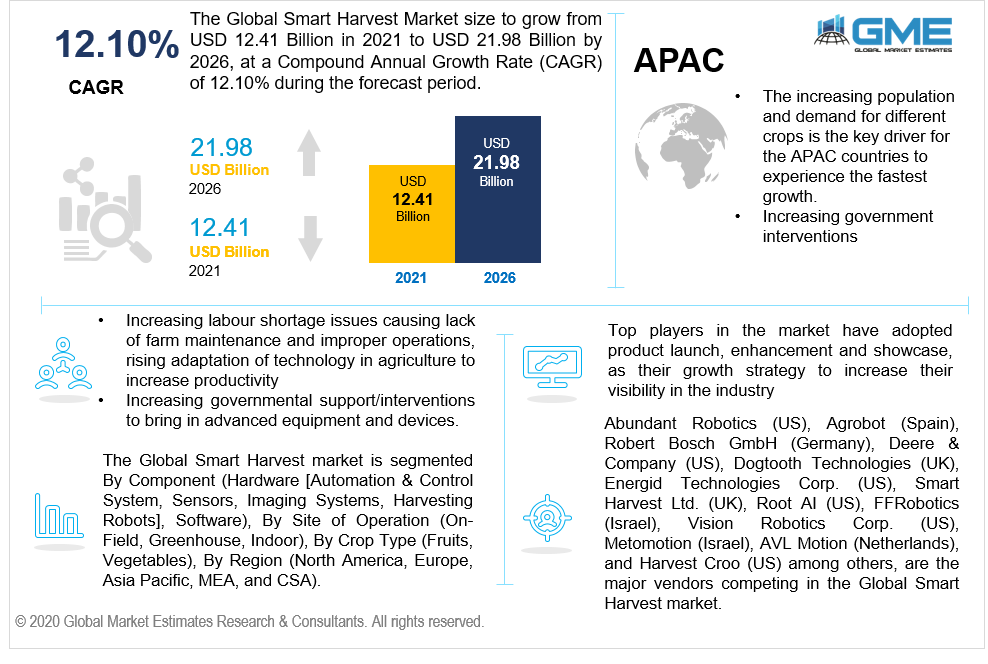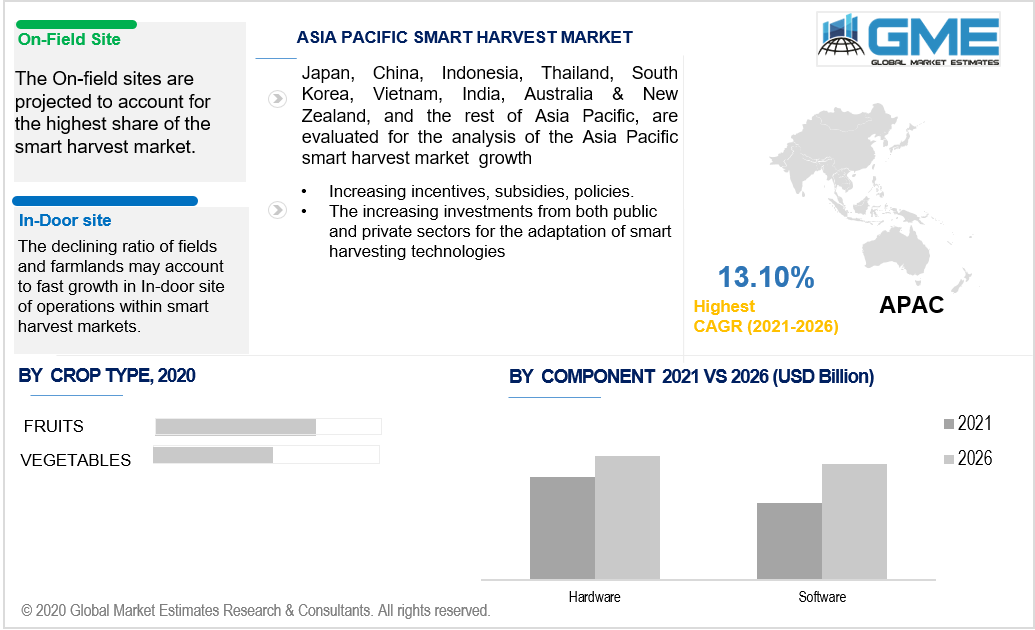
Global Smart Harvest Market Size, Trends, and Analysis - Forecasts to 2026 By Component (Hardware [Automation & Control System, Sensors, Imaging Systems, Harvesting Robots], Software), By Site of Operation (On-Field, Greenhouse, Indoor), By Crop Type (Fruits, Vegetables), By Region (North America, Europe, Asia Pacific, MEA, and CSA), Competitive Landscape
The global population has been constantly growing for decades, causing drastic changes in the lifestyle and demand among individuals. With the increasing population, the pressure on agriculture is also increasing. With consumers on one end and farmers on the other, technology has helped bring stability in the demand market, by assisting the farmers to fulfil the hunger need of the increasing population. Farmers have experienced tremendous profit along with rising productivity since the time technologically driven equipment and mechanisms have been adapted into agriculture and its allied sector.
Smart harvesting makes it easy for the farmers to harvest more in a less time-consuming and cost-effective manner, with the help of technology, electronic control devices, GPS, and Artificial Intelligence (AI). Applications like smart harvesting and other technological mechanisms are encouraging the young generation of farmers to utilize their technical degrees and skills in practicality. Also, in recent periods, with a larger proportion of youngsters preferring and securing their jobs in sectors other than agriculture, is leading to a shortage in the labor force in agriculture and its allied sector. This issue of the inadequate labor force has also led to the adaptation of smart harvesting mechanisms to the fields to bring efficiency in farm maintenance and operations.
Many previous records also highlight the annual operational expenditure of individual farm owners. 60% of the expenditure or operational costs account for harvesting. The majority of the costs are incurred on the wages paid to the seasonal laborers appointed during the harvesting period. Smart harvesting systems enable farmers to reduce their costs and earn more profits. These smart harvesting systems are driven by artificial intelligence, making them efficient in inspecting crop qualities, mapping the yields and cropping patterns. These systems also facilitate bulk harvest, thus bringing in more productivity and time management. These advanced harvesting mechanisms have attached sensors to them which assists the farmers to gain geospatial data on the quality of soil, presence of rodents, and other details that enable farmers to take required control mechanisms in the farmlands.
Governments of different countries have been encouraging farmers to adopt these smart harvesting systems by providing incentives. The increasing Foreign Direct Investments (FDIs), along with investments from private enterprises and CSRs are enabling farmers to adopt smart harvesting.

Smart harvesting mechanism works on hardware as well as software components. The hardware-based smart harvesting incorporates a few aspects like Automation & Control System, Sensors, Imaging Systems, and Harvesting Robots. The hardware-based smart harvesting systems are adopted majorly today as compared to the software component. Hardware components facilitate advanced features like control systems and robots that tremendously contribute to increasing the profitability of the farmers. The hardware component helps the farmers to have a detailed analysis of moisture levels in the soil, and coordinative harvesting patterns of fruits and vegetables.
Although, the increasing application of programs and the Internet of Things (IoT), the software-based smart harvesting mechanisms are also gaining popularity. This software component is gradually gaining growth into the market through its highly functional properties.
Smart harvesting mechanisms can be operated on, On-field sites, greenhouse sites, and in-door sites. These harvesting systems are mainly adopted on the on-field sites by the farmers and agri-entrepreneurs. The bulk harvesting mechanism of these smart harvesting systems assists the farmers to utilize their time efficiently and productively. The characteristics and components that come under these smart mechanisms like harvesting robots, AI, and other control systems show exceptionally positive results when used on on-field sites. The usage of smart harvesting systems on-field reduces the production cost and increases profitability, thus blurring the negative impact of the labor shortage. However, the declining ratio of fields and farmlands may account for fast growth in the In-door site of operations within smart harvest markets.
Smart harvesting systems can be utilized in harvesting a variety of fruits and vegetables. The Hardware component has been majorly able to bring in harvesting technologies, systems, and devices that support harvesting fruits. Thus, farmers and Agri-entrepreneurs have applications of smart harvesting in fruit farms compared to vegetable farms. The food-factory owners in Europe and North-American region prefer having their field of fruits required in the production of the processed food product. Keeping track of the quantity of fruit yield required to be harvested becomes easier for these owners through the adaptation of smart harvesting systems.
However, manufacturers have also started tests and trials to bring in smart harvesting mechanisms for vegetables.

Europe has witnessed mass adaptation of smart harvesting mechanisms over the last few years. Farmers in this region have strong incentives and financial assistance from the government in the adaptation of these technologically driven harvesting systems. Europe is also a huge center of vendors and manufacturers of smart harvest systems.
Asia-Pacific has been experiencing a gradual increase in the implementation of smart harvesting mechanisms attributed to the increased awareness among the young generation of farmers and budding Agri-entrepreneurs about the advantages of these smart systems. The increasing population, as well as the increasing demand for a variety of fruits and vegetables in higher quantities, is also encouraging the farmers in the APAC region to adopt this mechanism. Every year with new budgetary policies, the governments of these countries are trying to allocate more funds into the agriculture sector, to assist small-scale farmers with loans and other subsidies thus enabling them to make use of advancing technological mechanisms. Along with government funds, the increasing investments from both public and private sectors for the adaptation of smart harvesting technologies and devices are also leading to the fast growth of APAC countries.
Abundant Robotics (US), Harvest Croo (US), Agrobot (Spain), AVL Motion (Netherlands), Robert Bosch GmbH (Germany), Vision Robotics Corp. (US), Metomotion (Israel), Deere & Company (US), FFRobotics (Israel), Dogtooth Technologies (UK), Root AI (US), Energid Technologies Corp. (US), Panasonic Corporation (Japan), Smart Harvest Ltd. (UK), Iron Ox (US), and Harvest Automation(US) among others, are some of the prominent industry players within the market.
Please note: This is not an exhaustive list of companies profiled in the report.
In January 2018, Panasonic Corporation (Japan) announced a tomato grower robot mechanized on complete automation in Tokyo. This advancement was brought in to facilitate the increasing demand from the rising population in the country.
We value your investment and offer free customization with every report to fulfil your exact research needs.
The Global Smart Harvest Market has been studied from the year 2019 till 2026. However, the CAGR provided in the report is from the year 2021 to 2026. The research methodology involved three stages: Desk research, Primary research, and Analysis & Output from the entire research process.

The desk research involved a robust background study which meant referring to paid and unpaid databases to understand the market dynamics; mapping contracts from press releases; identifying the key players in the market, studying their product portfolio, competition level, annual reports/SEC filings & investor presentations; and learning the demand and supply-side analysis for the Smart Harvest Market.

The primary research activity included telephonic conversations with more than 50 tier 1 industry consultants, distributors, and end-use product manufacturers.

Finally, based on the above thorough research process, an in-depth analysis was carried out considering the following aspects: market attractiveness, current & future market trends, market share analysis, SWOT analysis of the company and customer analytics.

Tailor made solutions just for you
80% of our clients seek made-to-order reports. How do you want us to tailor yours?
OUR CLIENTS